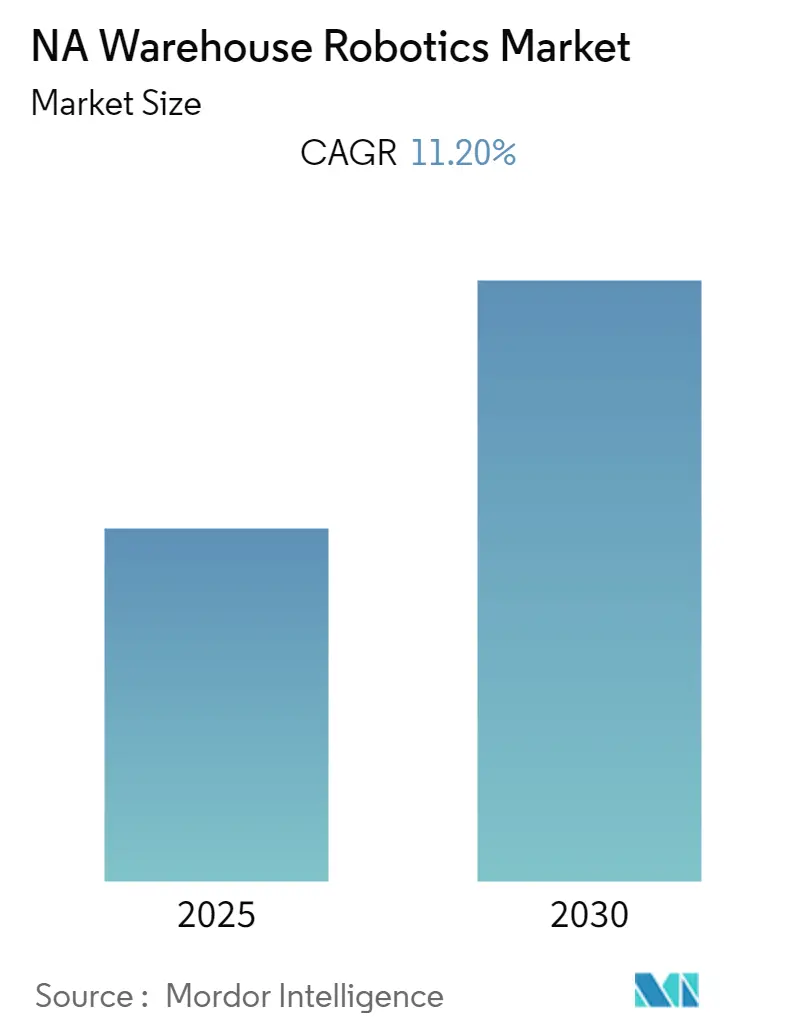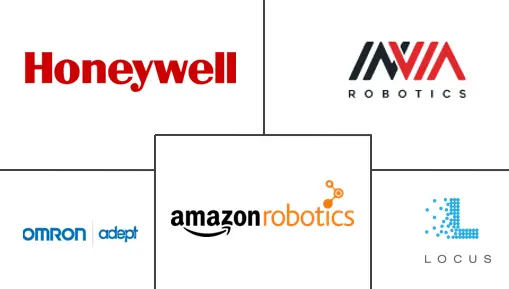
North America Warehouse Robotics Market Analysis
The NA Warehouse Robotics Market is expected to register a CAGR of 11.2% during the forecast period.
- Significant technological advancements, such as sensors technologies which enable an enhanced object perception and an accurate positioning system, have made way for the robotics industry to explore the untapped potential in various warehousing applications, while attaining an optimal operational flow and logistics efficiency, among other accomplishments, across the different industry verticals.
- According to the British Government's Health and Safety Statistics, in 2015, the rate of fatal injuries at work in Great Britain was 0.46 fatalities per 100,000 workers with over 144 worker deaths, compared to 142 fatal deaths in 2014. The numbers are comparable to the United States at 3.4 per 100,000 which has a higher fatality ratio. The percentage of employees taking time off from work due to workplace injuries is also one of the factors concerning the companies. Labor time off and medical expenses increase the costs of the companies, thus affecting the total expenditure. According to Occupational Safety and Health Act (OSHA), It has been estimated that companies around the world spend around USD 1 billion per week as compensation for workplace injuries. Thus, the need for providing safer workplaces is the primary focus in industries.
- Furthermore, various food distribution companies are embracing the automatic storage and retrieval systems (AS/RS). According to Dematic, a supplier of integrated automated technology, software, and services in the United States, more than 50% of its food distribution customers are adopting AS/RS to existing buildings.
- The outbreak of Coronavirus and the lockdown across the world have affected the warehousing and industrial activities, especially in countries, such as the United States, the United Kingdom, France, and Israel, which manufacture a significant portion of the warehouse robots, such as Automated Storage and Retrieval Systems (AS/RS), Automated Guided Vehicles (AGVs), Automated Guided Carts (AGCs), Autonomous Mobile Robots (AMRs), and others, such a Articulated Robotic Arms and Unmanned Aerial Vehicles.
North America Warehouse Robotics Market Trends
Growth of E-commerce in Developing Countries
- E-commerce is growing at a very fast rate from the last few years. Many companies have moved from physical retail to online to better cater to consumer requirements. Many of the large companies have bet big on the technology, to provide reliable consumer service. North American region has been pioneers in online retail and have established markets with large players.
- E-commerce penetration amounts to 62% in Tier 3 and 4 cities and 89% in Tier 1 and 2 cities. The online consumers count in Tier 3 and 4 cities is around 257 million, which is larger than that most of the countries in the world. For example, Alibaba logistics arm itself owns 180,000 express delivery stations in China. In addition the specific sale days in festive season requires them for scale up and down thus driving the demand for solutions that have the flexibility to volume changes in material handling.
- The relentless march of e-commerce is continuously putting tremendous strain on distribution and fulfillment operations. The online retail sales reached 8% of total retail spending in 2018, as compared to 7.4% in 2016. Moreover, the digital buyer penetration worldwide increased from 42.7% in 2014 to 47.3% in 2018, according to Invesp.
- This has led to an increasing pressure on supply chain activities. According to a recent survey conducted by Honeywell Intelligrated, of the 171 US-based material-handling executives, 35% of executives found that fulfilling more orders (faster and at lower costs) was their primary challenge. While their secondary concern was to reduce errors in order processing/improving order accuracy and obtain enough labor to support operations.
- Furthermore, more convenient cross-border payments methods like UniPay and PayPal have also boosted the transactions on the e-commerce platforms. With such reliable and convenient cross border transactions and boom of e-commerce, consumers have reduced their patronage to brick and mortarstores for shopping. This is resulting in the expansion of online retail market and companies are thus investing heavily to improve the technology. With logistics playing major part in online retail, warehouse and delivery stations are one of the crucial points in the e-commerce segment.

United States is Expected to Witness Significant Growth
- Growth in e-commerce is the primary reason for the increasing application of robots in warehouse and distribution centers in the United States, in addition to advancements in technology that have made robots better and smaller, lower costs, and a shortage of labor in some places.
- The country is witnessing the decline of middle-skill occupations, like manufacturing and production jobs, and the growth in both high and low-skill occupations, like managerial jobs on one end and jobs that assist or care for others. This is now popularly know as job polarization, which is driving the adoption of automation of various repetitive, manual, and low skill tasks.
- Also, the major companies with many warehouses and distribution units are utilizing acquisition strategies to reduce the labor cost and increase their profitability. For instance, Amazon, the giant retail, spent USD 775 million in 2012 to acquire a young robotics company called Kiva Systems that gave it ownership over a new breed of mobile robots. This investment gave a technical foundation on which it has to build new versions of warehouse robotics, setting the stage for a potential future of the robots.
- In another instance, till 2020, Amazon has installed more than 200,000 mobile robots that work inside its warehouse network, alongside hundreds of thousands of human workers in the United States. This robot army has helped the company fulfill its ever-increasing promises of speedy deliveries to Amazon Prime customers.
- Furtheremore, according to the International Federation of Robotics, sales of robots in the United States had hit a new peak of almost 38,000 units and set a record for the eighth year in a row from 2010 to 2018. Robot density in the US manufacturing industry is more than double that of China and ranks seventh worldwide. The trend to automate production in both the domestic and global markets is the main driving force of robot installations in the United States. The general industry sector, particularly the food and beverage industry (+64%) and the plastic and chemical products industry (+30%), had the highest growth.

North America Warehouse Robotics Industry Overview
The warehouse robotics market is moderately fragmented and consists of highly competitive players. In terms of market share, few of the major players such as Honeywell, and Kiva Systems(Amazon Robotics LLC) currently dominate the market. These major players with a significant share in the market are expanding their customer base across various regions and many companies are forming strategic and collaborative initiatives with various start-up companies to increase their market share and their profitability.
- September 2019 - Honeywell announced the signing of an agreement with the retail supply chain services provider. The Apparel Logistics Group to help the company to expand the e-commerce order output at its distribution center in Dallas. Under this agreement, Honeywell Intelligrated plans to provide automated material handling solutions to The Apparel Logistics Group, a provider of third-party logistics and order fulfillment services for apparel, footwear, and accessories.
- January 2020- Amazon announced the construction of a dedicated research and development center for its robotics business. The USD 40 million robotics hub will be located in Westborough, Massachusetts, covering 350,000 sq ft, and is scheduled to open by 2021
North America Warehouse Robotics Market Leaders
-
Honeywell International Inc.
-
Omron Adept Technologies
-
Kiva Systems (Amazon Robotics LLC)
-
InVia Robotics Inc.
-
Locus Robotics
- *Disclaimer: Major Players sorted in no particular order
North America Warehouse Robotics Industry Segmentation
Warehouse robotics refers to the usage of automated robots and specialized software that is used in the transportation of materials, performing various tasks, and streamlining or automating the whole warehouse processes. In recent years, robotics has gained significant importance in supply chain, distribution center, and warehouse management circles and continues to play a significant role in warehouse automation. The market is segmented based on type, function, end user, and Country.
| Type | Industrial Robots |
| Sortation Systems | |
| Conveyors | |
| Palletizers | |
| Automated Storage and Retrieval System (ASRS) | |
| Mobile Robots (AGVs and AMRs) | |
| Function | Storage |
| Plastic Bottles | |
| Packaging | |
| Trans-shipments | |
| Other Functions | |
| End User | Food and Beverage |
| Automotive | |
| Retail | |
| Electrical and Electronics | |
| Pharmaceutical | |
| Other End Users | |
| Country | United States |
| Canada |
North America Warehouse Robotics Market Research FAQs
What is the current NA Warehouse Robotics Market size?
The NA Warehouse Robotics Market is projected to register a CAGR of 11.2% during the forecast period (2025-2030)
Who are the key players in NA Warehouse Robotics Market?
Honeywell International Inc., Omron Adept Technologies, Kiva Systems (Amazon Robotics LLC), InVia Robotics Inc. and Locus Robotics are the major companies operating in the NA Warehouse Robotics Market.
What years does this NA Warehouse Robotics Market cover?
The report covers the NA Warehouse Robotics Market historical market size for years: 2019, 2020, 2021, 2022, 2023 and 2024. The report also forecasts the NA Warehouse Robotics Market size for years: 2025, 2026, 2027, 2028, 2029 and 2030.
Our Best Selling Reports
North America Warehouse Robotics Industry Report
Statistics for the 2025 NA Warehouse Robotics market share, size and revenue growth rate, created by Mordor Intelligence™ Industry Reports. NA Warehouse Robotics analysis includes a market forecast outlook for 2025 to 2030 and historical overview. Get a sample of this industry analysis as a free report PDF download.




